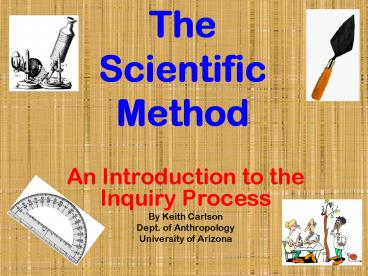The Scientific Method - PowerPoint PPT Presentation
1 / 19
Title:
The Scientific Method
Description:
process scientists use to answer questions and solve problems. ... Hypotheses and Specific Questions the Garbology Project Generated: ... – PowerPoint PPT presentation
Number of Views:42
Avg rating:3.0/5.0
Title: The Scientific Method
1
The Scientific Method
- An Introduction to the Inquiry Process
- By Keith Carlson
- Dept. of Anthropology
- University of Arizona
2
How do scientists know what they know?
Answer.
3
THE SCIENTIFIC METHOD!!!
- A step-by-step
- process scientists use to answer questions and
solve problems.
The steps of the Scientific Method are
4
THE SCIENTIFIC METHOD
- 1) Research Question
- The problem or issue you want to learn more
about. - 2) Hypothesis
- Testable Prediction that follows from your
research question that can be tested and
evaluated. - 3) Methods
- What will be your procedures for testing your
hypothesis? - 4) Data Collection
- Record observations regarding data related to the
problem you are interested in. - 5) Inferences/Interpretation
- What can you say about your hypothesis based on
your observations? Is your hypothesis supported
by your observations? - 6) Sharing your conclusions
- Scientists write reports and give presentations
to inform others about their research!
5
Applying the Scientific MethodArchaeology
6
Whats Archaeology and Whos anArchaeologist?
- Archaeology
- The study of human activity and the past through
material remains - Archaeologist
- A scientist who studies humans, past and present,
through their material remains - Uses the Scientific Method!!!
7
- Not all archaeologists study the past!
- Some investigate material remains from our own
society!!!
Bill Rathje http//www.psihoyos.com/pages/Stock/Po
rtraits/ rathje-william/pages/rathje-william0001.h
tml
8
The Garbology Project
- From Rubbish The Archaeology of Garbage, by
William Rathje and Cullen Murphy. The University
of Arizona Press, Tucson, 2001
9
The Garbage Project
- Began at the University of Arizona in 1973
- As part of their research method, project
personnel have studied over 250,000 lbs of
garbage from American households and Landfills
since 1973. - Research Question
- What can we learn about our own society from the
garbage we throw away?
10
Hypotheses
- First, what hypotheses do you have about what the
garbologists would find in the typical American
garbage and in Landfills?
The Garbage Project developed several hypotheses
and questions based on questionnaires and other
general knowledge.
11
Hypotheses and Specific Questions the Garbology
Project Generated
- Landfills are filling up with fast food packaging
and lots of plastic waste as based on surveys
of what many Americans think is in our waste. - Paper and food products biodegrade over time.
- What is the relationship between what people say
they do and eat, and what is actually found in
their garbage?
12
Methods and Data Collection
- How would you test the hypothesis?
metamedia.stanford.edu
Systematically excavate, or dig in landfill.
13
- Randomly collect household garbage.
14
Methods and Data Collection
http//metamedia.stanford.edu/projects/GarbologyOn
line
sort contents layer by layer and bag by bag
15
Methods and Data Collection
Rathje and Murphy (200173)
and record observations about what You
find!!!
16
Project Observations
- 1) Landfills contain almost 40 newspapers
between 15 and 40 years old!!!
- 2) Plastic bottles, soda cans, and fast food
- packaging less than 1!!!
- Items such as lettuce
- and old fruit lasted over 15 years!
17
Inferences - What do the observations mean?
Do the observations support the hypotheses?
NO!!! Landfills are not filling up with
plastics, but with paper and construction
products. Items that we would expect to
decompose do not always. Recycling of paper
products, in addition to plastics, is not a major
activity in modern society in comparison to the
total amount of garbage!
18
Conclusions
- Recycling, especially of paper, needs to be a
PRIORITY! - People need to find ways to compost!
- What people think is in their garbage is not
necessarily what is really there!!! and - What people say they eat and do is not always
necessarily the case!
19
Important references
- From Rubbish The Archaeology of Garbage, by
William Rathje and Cullen Murphy. The University
of Arizona Press, Tucson, 2001 - http//metamedia.stanford.edu/ projects/GarbologyO
nline































